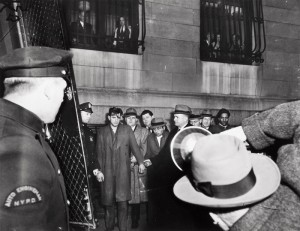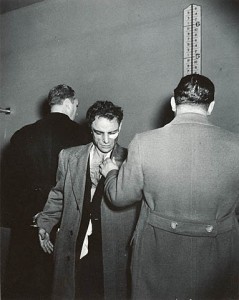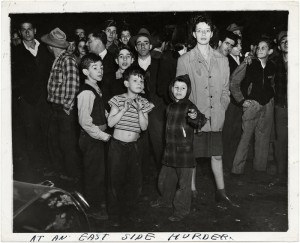The idea of social documentary photography seems to have a certain resonance with the current times. Images from Occupy Wall Street have put the lives of the vanishing middle (and burgeoning lower-middle) class on our websites, blogs, twitter feeds, the daily television news and local newspapers. So it seems almost an odd turn of fate that there are at least three simultaneous showings of the work of the mid-20th century news photographer Weegee at this time. With two exhibitions in New York and a third in LA at the Museum of Contemporary Art, the face of the average mid-20th century American pushes back at and rivets our attention as almost never before.

Arthur Fellig (1899-1968) known as Weegee, came to New York as a boy of 11 in 1909 and settled into the Lower East Side, the launching pad for thousands of immigrants in the early 20th century. He took up photography in 1935 and set out on a career as a freelance news photographer for the New York tabloid circuit in the 1940’s. The two exhibitions in New York, Weegee: Naked City at the Steven Kasher Gallery in Chelsea and Weegee: Murder is My Business at the International Center of Photography tie two of his central themes together, murder and naked. For Weegee, a tabloid photographer working in one of the most shocking and raw eras in the city, naked represented both the bold look at the unvarnished reality of life as well as the underworld scenes of mayhem, crime and horror. Life brought out from the darkness in Weegee’s hard unedited pictures showed people caught in a harsh new urban setting. There is an odd sense to his work, in that, in his images you the viewer are looking at the viewers on the scene. He was fascinated by the immediate crime scene, but also by those drawn out for a late night murder. No crime scene TV in those days, just the real deal spilling out across the street corner. And Weegee was always up for a story.
In Weegee: Naked City, we enter the world of the 10¢ cream soda and 15¢ glass of beer, where a ham and bologna sandwich would set you back a full 25¢. In this harsh world of bare minimums, the photographer caught his subjects in the harshest of flash photography – working with a larger format camera, he caught enough detail to get the scene right as well as capturing the sweat, grease and grit of this working class world. Many of his images are shot at night, which re-enforces the sense of a nightmare dream scene. While there is a stark attachment to reality in these images, the times and people caught out in the street appear in a more natural, less self-conscious world. Emerging from the Depression and War years, there was a sense of survival and an appreciation of the struggle of daily life. In one of the images, he catches four little kids and a kitten sleeping on the fire escape on a hot summer night. In another image, he captures a group of kids pressing forward in a cluster to get a better look at something just outside of the frame. This image he titled “Their First Murder”. And in this world Weegee himself became a kind local personality. He felt so connected to the phrase Naked City that he used it as the title of the autobiography he wrote in the mid 1940’s.

Weegee: Murder Is My Business, the exhibition at the ICP, takes its name from Weegee’s own popular exhibitions at the Photo League. While most of his work was intended to be sold to newspapers, he did have several exhibitions at the Photo League in 1941 in which he grouped images into broad themes like, “Sunday Tragedy”, “Society” or just “Murder”. He even “enhanced” some of the images for the show by adding red nail polish to bring out the gore.
The ICP exhibition chronicles the time from 1935 to 1946 when Weegee spent most of his time working at night following the fast-moving, often violent breaking news stories. Dead criminals‚ fires, gruesome accidents and other catastrophes were his usual subjects. But, beyond the crime scenes, he sought out photographs showing people hanging out of windows, peering over rooftops and standing in groups at the street corners, all watching. This became something of his signature style, his unique way of capturing the scene.

The exhibition includes at least one installation – a dramatic recreation of Weegee’s room – with a small iron bed, camera equipment, a typewriter and images strewn about the bed. On one wall in this little “scene”, a framed check-stub hangs on the wall. It shows his pay as “$35 for 2 Murders” and Life magazine as the source of that largesse. The little room represents the life of someone committed to his work – there is no room for anything but work, and there seems to be no time or interest in amenities. At that time, he lived a life as hard as his subjects.
While both exhibits cover the same period, they show the broadness of his interest, and his willingness to push out into the reality of the hard times of real lives. Both shows are generous in the number of images shown with over 140 images at Kasher gallery alone. All the images were gelatin silver, and the Kasher exhibition also includes film and audio recordings – the voice of wee gee live!!!!! yipes! Both exhibits are worth a look and they clearly show how his work paved the way for so many photographers in the 50’s and 60’s who understood and embraced the boldness of Weegee’s naked style.
Weegee: Naked City
January 12 – February 25, 2012
Steven Kasher Gallery | 521 W. 23rd Street
Weegee: Murder Is My Business
runs through Sept. 2, 2012
The International Center of Photography | 1133 Avenue of the Americas






